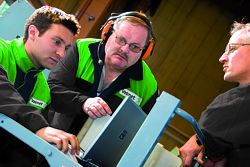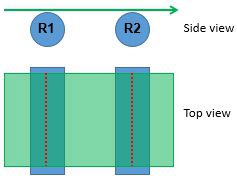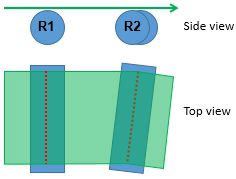Review of the types of roll misalignment and alignment methods
Feb 27, 2018

Types of roll misalignment
There are two types of roller misalignment we can measure, in-plane and out-of-plane. The plane we're referring to is the plane of the web going into a particular downstream roller.
Basically, rollers are in-plane aligned if they are parallel, i.e. a perfectly flat sheet laid on top of the rollers would touch the surface of each roller from tend side to drive side and those touchlines are parallel, shown by the red dashed lines in Figure 2.

Figure 2: In-plane aligned
If one end of one of the rolls is skewed downstream, but the rolls are still at the same level, as shown in Figure 3, the rolls are in-plane misaligned. They are in the same plane but not parallel to each other.

Figure 3: In-plane misaligned
Figure 4 shows an example of out-of-plane misalignment. In this case, one end of one of the rolls has been lowered so the rolls are out-of-plane.

Figure 4: Out-of-plane misaligned
In-plane alignment
For a horizontal run going into a downstream roller, the type of optical alignment that is performed to determine in-plane misalignment is the "square" measurement. Both upstream and downstream roller's square measurements are taken, preferably in relation to the machine's datum line, but not necessarily. After all, it is the difference between the upstream and downstream roller's square measurements that is more important than their relation to the machine datum.
For an up-run or down-run web path, the "level" of the two rollers is more important in determining in-plane alignment. In-plane alignment is the dominate factor that determines web tracking performance.
Out-of-plane alignment
Out-of-plane is the opposite of in-plane in the examples above. For the horizontal run example, the roller's "level" is compared between rollers. Out-of-plane alignment is not as important as in-plane alignment as any differences will be seen as a small twist to the web, a condition that does not affect the formation of baggy/tight lanes/wrinkles as much as in-plane alignment does.
[NOTE: David Roisum (roisum.com) has written articles on roller alignment, which also explain the relative impact on in-plane vs. out-of-plane misalignment. They can be found at the Association of International Metallizers, Coaters and Laminators (AIMCAL) website at www.aimcal.org.]
Optical alignment
Optical alignment is the measure of choice for rollers. For "square" measurements, the optical equipment is set up in line with the machine's main datum line. When checking for "square", measurements are taken on the tending and drive sides of the roll, at the 3:00 or 9:00 position of the roll face, whichever is easier to get at. The drive side is usually assumed to be the reference side, so its relative position is zero. The tending side is measured in reference to the drive side. A "square" result also is documented as to which side the tending side is, either to the wet end or dry end of the machine.
Pi tape alignment
A quick method to check roll-to roll-alignment is to use a Pi tape. Check distance around both rolls, on the tending and drive side. This gives you a relative difference. It does not show which roll to move. More readings may need to be taken of upstream or downstream rollers to determine which roller is the problem. Acceptable tolerances vary depending on many factors.
If you need assistance with roll alignment, your Valmet service representative has tolerance information and experience in setting roll alignments.